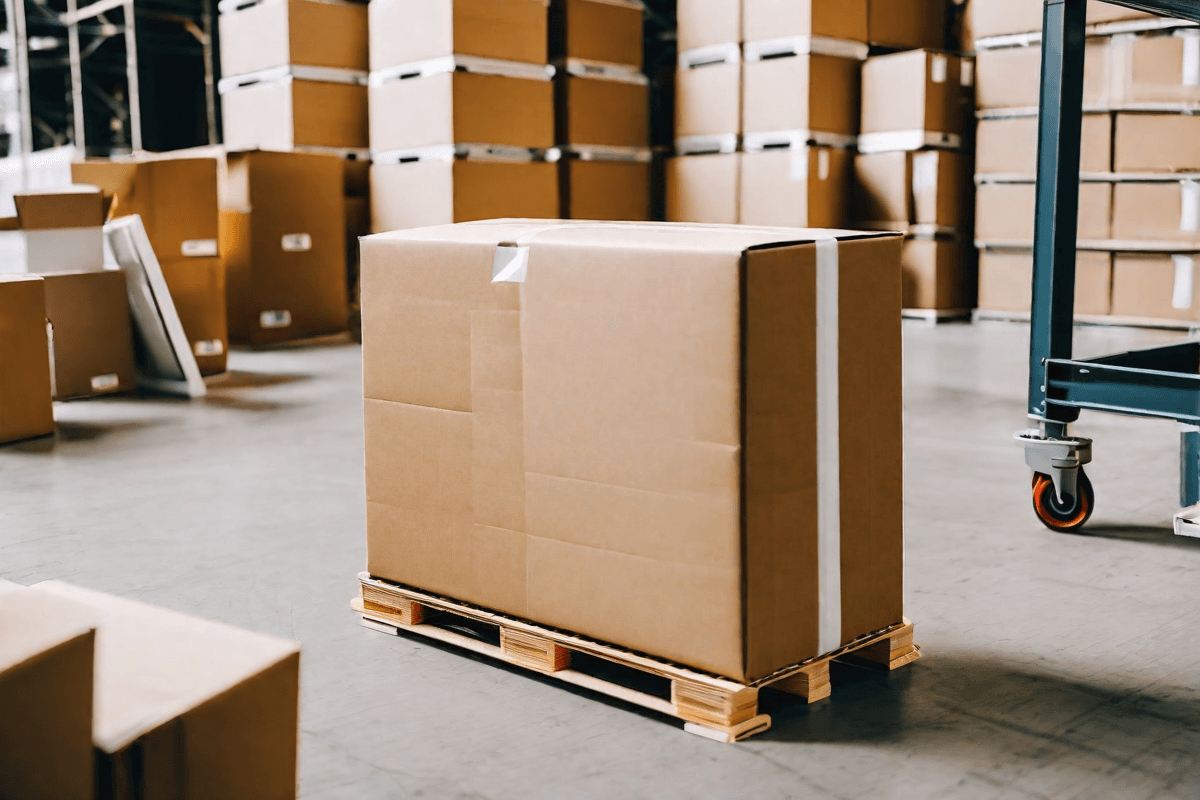
Devanning: Definition, Guide, and What It Means in Ecommerce
Imagine you're eagerly awaiting the delivery of a long-awaited package from an online retailer. Finally, the day arrives, and a delivery truck pulls up to your doorstep. Inside that truck, there's a process called devanning taking place, which is crucial to the in the ecommerce industry. In this article, we will explore the concept of devanning, its role in ecommerce operations, and its future trends, giving you a comprehensive guide to understanding this essential process.
Understanding the Concept of Devanning
Before we delve into the nitty-gritty details, let's start with the basics: devanning. Devanning, also known as container unloading, is the process of unpacking goods from shipping containers upon arrival at a designated facility. These containers, which are typically transported by cargo ships or trucks, are like treasure chests full of goods eagerly awaited by retailers and consumers alike.
When a container arrives at its destination, it is often a moment of excitement and anticipation. The container, towering over the workers like a giant metal box, holds the promise of new products, the latest gadgets, or even essential supplies. It is a tangible representation of the global economy, connecting people and businesses across vast distances.
But before these goods can reach the eager hands of consumers, the process of devanning must take place. It is a crucial step in the supply chain, ensuring that the right products are efficiently distributed to their respective destinations.
The Basic Definition of Devanning
At its core, devanning involves unloading a container and efficiently distributing its contents into the appropriate areas of a warehouse or distribution center. It is a meticulous and carefully coordinated task that requires precision, organization, and expertise to ensure a smooth flow of goods throughout the supply chain.
Imagine a team of skilled workers, armed with the necessary tools and equipment, . Each box, crate, or pallet is carefully inspected, ensuring that the goods are in pristine condition. The workers work in harmony, like a well-choreographed dance, as they swiftly move the products to their designated locations within the facility.
But devanning is not just about unloading and distributing goods. It is also about , ensuring that every item is accounted for. This meticulous attention to detail is crucial for inventory management, allowing businesses to track their stock levels and make informed decisions about restocking or replenishing their supplies.
The History and Evolution of Devanning
Devanning has been an integral part of logistics and commerce for centuries. In the past, when trade primarily involved bartering or local exchanges, devanning was a simple process of unloading goods from a cart or ship. It was a labor-intensive task, relying on the strength and endurance of workers to manually handle each item.
As trade expanded and global connections grew stronger, the need for efficient devanning processes became evident. The rise of containerization in the mid-20th century revolutionized the shipping industry and, consequently, the devanning process. Standardized shipping containers allowed for easier handling, transportation, and storage of goods, streamlining the entire logistics process.
With the advent of global trade and the rise of ecommerce, devanning has evolved to become a specialized and efficient operation. Innovations in technology, cargo handling equipment, and supply chain management practices have further revolutionized this essential aspect of the ecommerce industry. Automated systems, such as conveyor belts and robotic arms, have increased efficiency and reduced the physical strain on workers.
Moreover, the increasing demand for speed and accuracy in the delivery of goods has led to the development of advanced tracking and tracing systems. These systems enable businesses to monitor the movement of their products throughout the supply chain, ensuring timely delivery and customer satisfaction.
In conclusion, devanning is more than just unloading a container. It is a complex and vital process that ensures the smooth flow of goods from the point of origin to the final destination. From the humble beginnings of manual unloading to the modern-day automated systems, devanning has come a long way, adapting to the changing needs of the global economy.
The Devanning Process Explained
Now that we have a grasp of the concept, let's dive into the devanning process itself. It involves several key steps, each crucial to ensuring the timely and accurate distribution of goods.
Step one involves inspecting the container upon arrival to ensure it is undamaged and suitable for unloading. This ensures the safety of both the workers and the goods inside. The container is carefully examined for any signs of damage, such as dents, cracks, or leaks. Additionally, the temperature and humidity levels inside the container are checked to ensure that the goods have been stored under optimal conditions during transit.
Next, the container is positioned in a designated area, ready for unloading. Specialized forklifts and other equipment are used to move and open the container, exposing its valuable contents. The forklift carefully lifts the container and places it in the designated area, ensuring that it is stable and secure. Once in position, the container's doors are unlocked and opened, revealing the tightly packed cargo inside.
Once the container is open, it's time for the real magic to happen. Workers carefully remove pallets, crates, or individual packages from the container, inspecting them for damage or any other issues that may have occurred during transit. This step requires attention to detail and a keen eye for quality control. Each item is checked for signs of mishandling, such as broken seals, torn packaging, or visible damage. Any discrepancies are immediately reported to the supervisor for further investigation.
After the goods have been unloaded, they are organized and sorted based on their destination. This could be different aisles, zones, or even specific customer orders. The items are grouped together based on their intended final location, making it easier for the next stage of the distribution process. This organization ensures that the goods can be easily located and retrieved when needed, minimizing delays and improving overall efficiency.
Finally, the unloaded goods are moved to their designated storage areas, where they await further processing or shipment to their final destinations. Depending on the nature of the goods, they may be stored in racks, shelves, or specialized storage units. Each item is carefully placed in its designated spot, ensuring that it is easily accessible and protected from any potential damage. This step requires precision and careful handling to avoid any accidents or mishaps that could result in product loss or delay.
Tools and Equipment Used in Devanning
To carry out the devanning process efficiently, various tools and equipment have become an integral part of the operation. Forklifts, pallet jacks, conveyor belts, and even automated systems are used to handle and transfer goods. These tools minimize physical labor, improve productivity, and ensure the safety of both workers and the goods being handled.
Forklifts are essential for lifting and moving heavy containers, pallets, and crates. They are equipped with hydraulic systems that allow them to lift and lower loads with ease. Pallet jacks, on the other hand, are used for moving individual pallets or smaller loads within the storage area. These manual tools are maneuverable and can navigate tight spaces, making them ideal for smaller-scale operations.
Conveyor belts are used to transport goods from one area to another, eliminating the need for manual handling. They are especially useful for moving items over long distances or between different sections of the warehouse. Automated systems, such as robotic arms or sorting machines, are employed in larger-scale operations to streamline the devanning process. These systems can handle a high volume of goods with precision and speed, further improving efficiency.
In addition to these tools, safety equipment such as hard hats, gloves, and high-visibility vests are provided to workers to ensure their well-being. Training programs are also implemented to educate employees on proper handling techniques and safety protocols, reducing the risk of accidents and injuries.
The Role of Devanning in Ecommerce
Now that we have a clear understanding of the devanning process, let's explore its vital role in the world of ecommerce.
Devanning, also known as container unloading, is the process of unloading and organizing goods from shipping containers. It plays a crucial role in the efficient handling and distribution of goods in the ecommerce industry. By swiftly unloading and organizing containers, devanning ensures that goods reach their destination in a timely manner.
This timely turnaround time allows ecommerce retailers to fulfill customer orders promptly, leading to higher customer satisfaction and repeat business. Imagine a customer eagerly waiting for their online purchase to arrive. Thanks to efficient devanning, their package is quickly processed and shipped, resulting in a positive shopping experience.
How Devanning Facilitates Ecommerce Operations
Devanning facilitates ecommerce operations in several ways. Firstly, it enables the smooth flow of goods from the container to the warehouse or distribution center. This seamless transition ensures that inventory is readily available for order fulfillment.
Secondly, devanning allows for efficient inventory management. As goods are unloaded and organized, they can be easily counted, inspected, and stored. This organized and easily accessible inventory enables ecommerce businesses to respond quickly to customer demands and adapt to changing market conditions.
Furthermore, devanning plays a crucial role in ensuring the accuracy of inventory records. By carefully unloading and verifying the received goods, any discrepancies or damages can be identified and addressed promptly. This attention to detail helps ecommerce retailers maintain accurate stock levels and avoid customer dissatisfaction due to incorrect or damaged items.
The Impact of Devanning on Ecommerce Efficiency
Efficient devanning directly impacts the overall efficiency of ecommerce operations. By streamlining the movement of goods from containers to storage areas, ecommerce retailers can save time and effort, reducing operational costs and increasing productivity.
Imagine a large shipment of products arriving at a warehouse. Without devanning, the process of unloading and organizing the goods would be time-consuming and labor-intensive. However, with efficient devanning practices in place, the unloading process becomes much smoother and faster, allowing ecommerce businesses to handle larger volumes of goods efficiently.
Moreover, with organized and easily accessible inventory, ecommerce businesses can respond quickly to customer demands. When an order is received, the necessary items can be retrieved promptly from the well-organized storage areas, minimizing the time between order placement and shipment.
Additionally, efficient devanning enables ecommerce retailers to adapt to changing market conditions. By quickly unloading and organizing new shipments, businesses can introduce new products or respond to trends in a timely manner. This agility in inventory management can give ecommerce businesses a competitive edge in a fast-paced market.
In conclusion, devanning plays a vital role in the world of ecommerce. It facilitates the efficient handling and distribution of goods, leading to timely order fulfillment, higher customer satisfaction, and increased operational efficiency. With its impact on inventory management and overall ecommerce operations, devanning is a crucial process that enables businesses to thrive in the dynamic world of online retail.
The Benefits and Challenges of Devanning
While devanning brings many benefits to the ecommerce industry, it also presents its fair share of challenges. Let's explore both sides of the coin.
Advantages of Implementing Devanning in Ecommerce
Implementing devanning in ecommerce operations offers numerous advantages. It enhances operational efficiency, reduces handling time, improves inventory management, and minimizes the risk of damaged goods. Moreover, devanning allows ecommerce businesses to scale their operations effectively, handle larger volumes of goods, and meet the growing demand of their customers.
Potential Drawbacks and How to Overcome Them
However, devanning is not without its challenges. It requires skilled labor, proper training, and investments in equipment and technology. Furthermore, handling fragile or perishable goods demands extra care and expertise. To overcome these challenges, ecommerce businesses should invest in workforce training, adopt advanced technologies, and collaborate with experienced logistics partners who specialize in devanning.
Future Trends in Devanning and Ecommerce
As technology continues to advance, devanning and the ecommerce industry are set to undergo exciting transformations.
Technological Innovations in Devanning
The future of devanning lies in technological innovations that streamline the process, enhance safety, and optimize efficiency. Robotics and automation are poised to play a significant role in the devanning operations of tomorrow. Robots equipped with artificial intelligence and machine learning capabilities can handle repetitive tasks, making the devanning process faster, more accurate, and less labor-intensive. Similarly, virtual reality and augmented reality systems could revolutionize container inspection and goods handling, further improving the safety and effectiveness of devanning processes.
The Future of Devanning in the Ecommerce Industry
Devanning will continue to be a vital component of the ecommerce industry. As ecommerce continues to grow and thrive, the demand for efficient devanning processes will only increase. Ecommerce businesses will strive to adopt faster, more automated, and technologically advanced devanning solutions to keep up with rising consumer expectations and stay ahead of competitors. The future of devanning in the ecommerce industry is undoubtedly bright, promising better customer experiences and more streamlined operations.
Conclusion
In conclusion, devanning plays a pivotal role in the ecommerce industry, enabling the efficient unloading, organization, and distribution of goods. It has come a long way from its humble beginnings and continues to evolve alongside advancements in logistics technology. Understanding the devanning process, its benefits, and the challenges it presents will equip ecommerce businesses with the knowledge they need to make informed decisions and optimize their operations. With its promising future and potential for innovation, devanning remains an essential aspect of the thriving ecommerce ecosystem.
Nitro Logistics Team
Logistics Expert
The Nitro Logistics team brings together decades of experience in logistics, fulfillment, and supply chain optimization.
Stay Updated
Get the latest insights in logistics and fulfillment delivered to your inbox.


